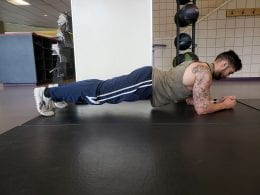One of the most common core exercises is the plank. It can be a great exercise because it involves a lot more core strength than any single ab muscle alone can provide.
The plank recruits muscles from the rectus abdominis, transverse abdominis, internal and external obliques, and several muscles in the back. It even places stress on the legs, shoulders, and arms, making it a full body exercise.
If you do it right. So how do you know if your form is good? What if you can plank for over a minute? (Read more below)
Pictured on top is a picture of a plank with bad form, and how most individuals I’ve seen doing a plank preform the exercise, especially when fatigue sets in.
The problem is the lower back is sagging, even though the body as a whole is relatively straight. To fix this, try to posteriorly tilt your pelvis. This means tilting the front of your hips up while tilting the back of your hips down, like tucking your tail bone.
This position decreases the exaggeration of curvature in the lower back, as seen in the middle picture. This keeps you in a safer position, and greatly increases the involvement of your lower abs.
If you can maintain that position with some ease, move your body into a long lever position. Do this by scooting your elbows forward of your shoulders a few inches as shown in the bottom picture.
This is a very challenging position to hold. The greater the challenge the greater the reward. If you have already mastered planks with pelvic tilt, move on to the long lever position while maintaining the tilt and low back integrity.
Check out the study below for more information on how this exercise really effects abdominal and core contraction.
Schoenfeld, B. J., Contreras, B., Tiryaki-Sonmez, G., Willardson, J. M., & Fontana, F. (2014). An electromyographic comparison of a modified version of the plank with a long lever and posterior tilt versus the traditional plank exercise. Sports biomechanics, 13(3), 296-306.
~GT the PT



